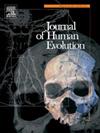A phylogenetic perspective on the evolution of early hominin foot morphology
IF 3.1
1区 地球科学
Q1 ANTHROPOLOGY
引用次数: 0
Abstract
Changes in foot morphology have played a crucial role in the evolution of bipedalism. Examining the evolution of pedal characters among hominins makes it possible to identify when and where key anatomical changes required for bipedalism evolved. This study uses ancestral character reconstruction to investigate foot morphology in the Homo + Pan last common ancestor and subsequent nodes in the hominin phylogeny. We explore the pattern of hominin foot evolution and examine the presence of terrestrial and arboreal adaptations at hominin ancestral nodes. In this study, we analyzed 62 discrete pedal characters hypothesized to be functionally significant. Our likelihood-based approach supports the hypothesis of a Pan-like last common ancestor of humans and chimpanzees. The earliest foot synapomorphies in hominins are related to foot and ankle eversion and midtarsal stability. These results are consistent with the hypothesis that lateral midfoot stability might have evolved before medial midfoot stability. Moreover, several homoplasies were inferred across different taxa, particularly related to features hypothesized to reflect joint mobility and the longitudinal arch. Finally, the Paranthropus and the Australopithecus africanus + Australopithecus sediba clades evolved arboreal characteristics, suggesting adaptations for arboreality. Overall, the results demonstrate how pedal characters evolved in hominins from an African ape–like ancestor.
早期人族足部形态进化的系统发育研究
足部形态的变化在两足动物的进化中起着至关重要的作用。研究古人类脚部特征的进化,可以确定两足动物进化所需的关键解剖变化的时间和地点。本研究采用祖先特征重建的方法,研究了Homo + Pan最后共同祖先的足部形态及其在人族系统发育中的后续节点。我们探索人类足进化的模式,并检查在人类祖先节点的陆地和树木适应的存在。在这项研究中,我们分析了62个离散的踏板特征,假设它们在功能上是显著的。我们基于可能性的方法支持人类和黑猩猩的最后共同祖先类似潘的假设。古人类最早的足部突触与足部和踝关节外翻以及中跗骨稳定性有关。这些结果与外侧足中部稳定性可能在内侧足中部稳定性之前进化的假设一致。此外,在不同的分类群中推断出了一些同源性,特别是与反映关节活动和纵向弓的假设特征有关。最后,类人猿和非洲南方古猿+南方古猿sediba进化出了树栖特征,表明它们适应了树栖生活。总的来说,结果证明了脚踏板特征是如何从非洲猿类祖先进化而来的。
本文章由计算机程序翻译,如有差异,请以英文原文为准。
求助全文
约1分钟内获得全文
求助全文
来源期刊

Journal of Human Evolution
生物-进化生物学
CiteScore
6.30
自引率
15.60%
发文量
104
审稿时长
3 months
期刊介绍:
The Journal of Human Evolution concentrates on publishing the highest quality papers covering all aspects of human evolution. The central focus is aimed jointly at paleoanthropological work, covering human and primate fossils, and at comparative studies of living species, including both morphological and molecular evidence. These include descriptions of new discoveries, interpretative analyses of new and previously described material, and assessments of the phylogeny and paleobiology of primate species. Submissions should address issues and questions of broad interest in paleoanthropology.
 求助内容:
求助内容: 应助结果提醒方式:
应助结果提醒方式:


